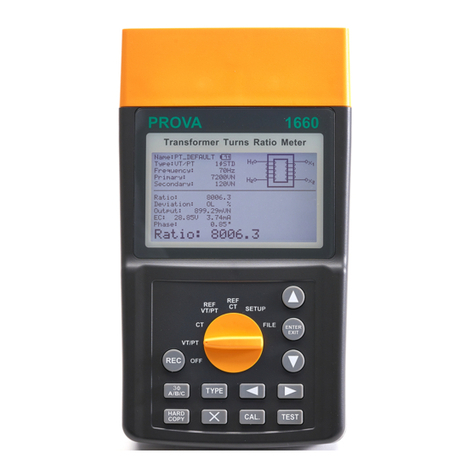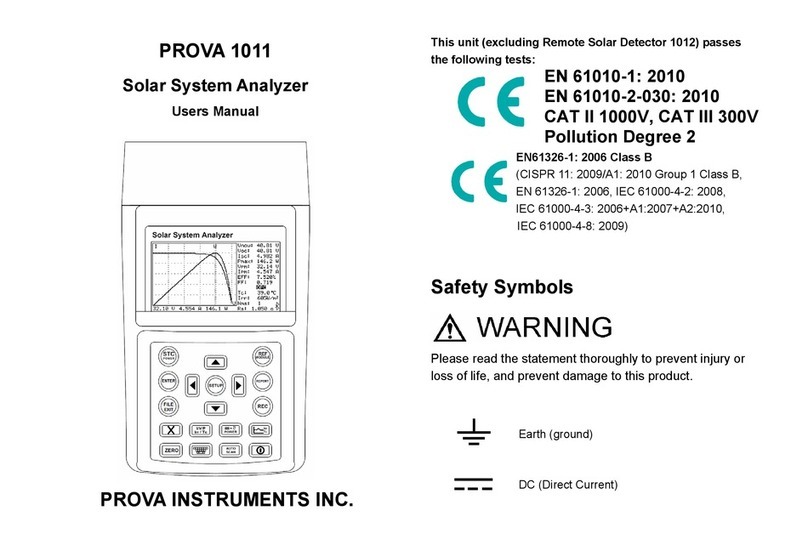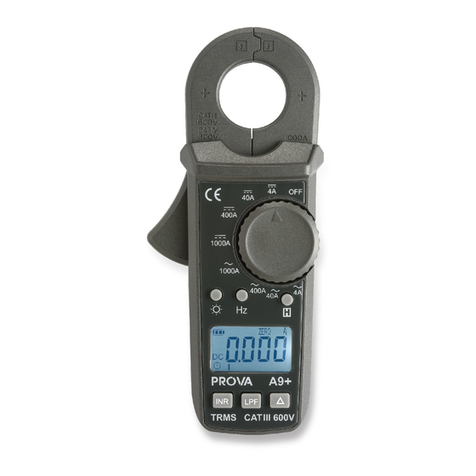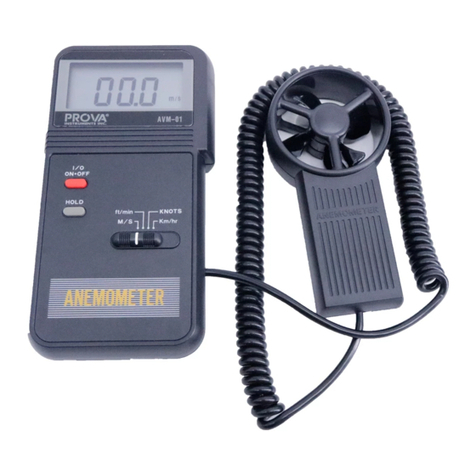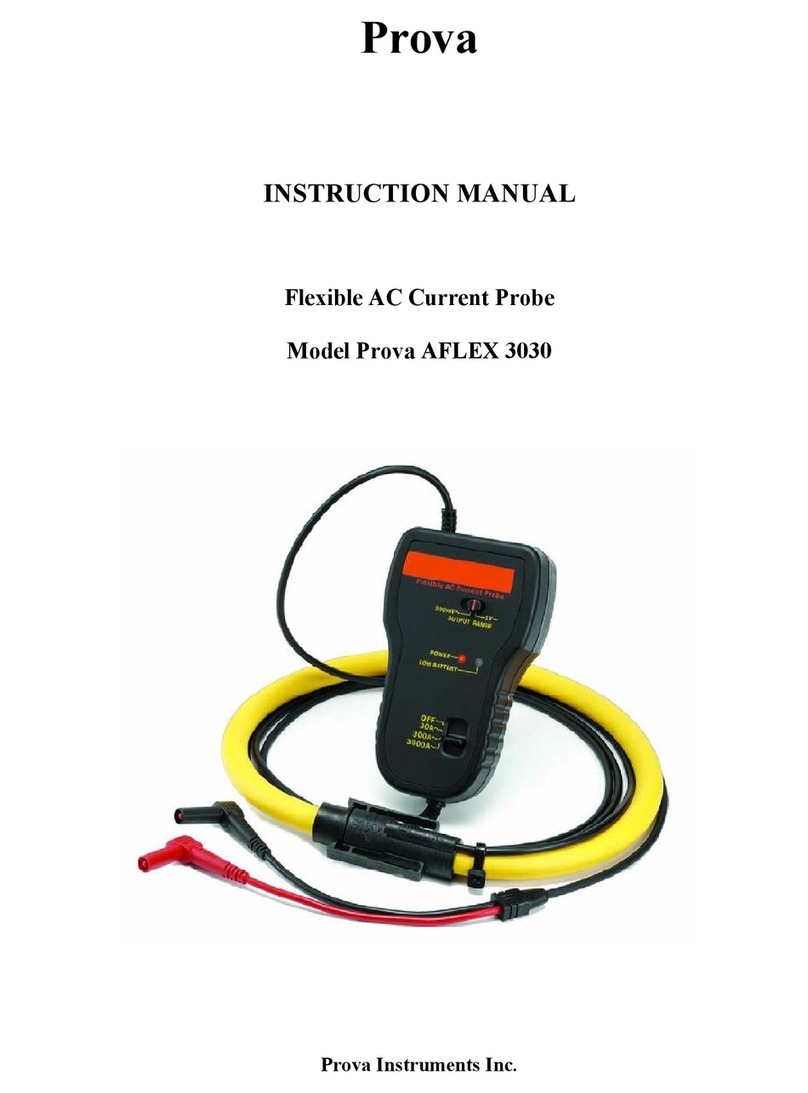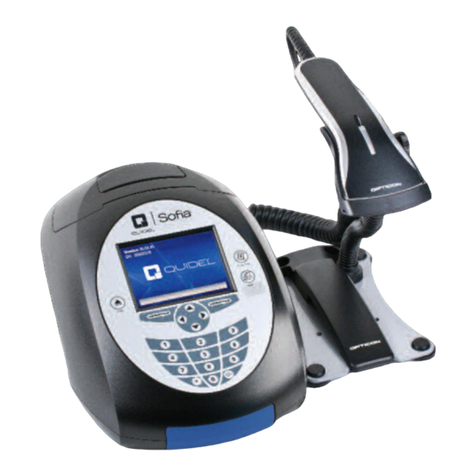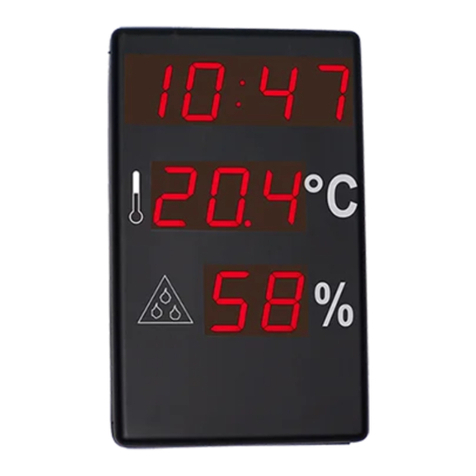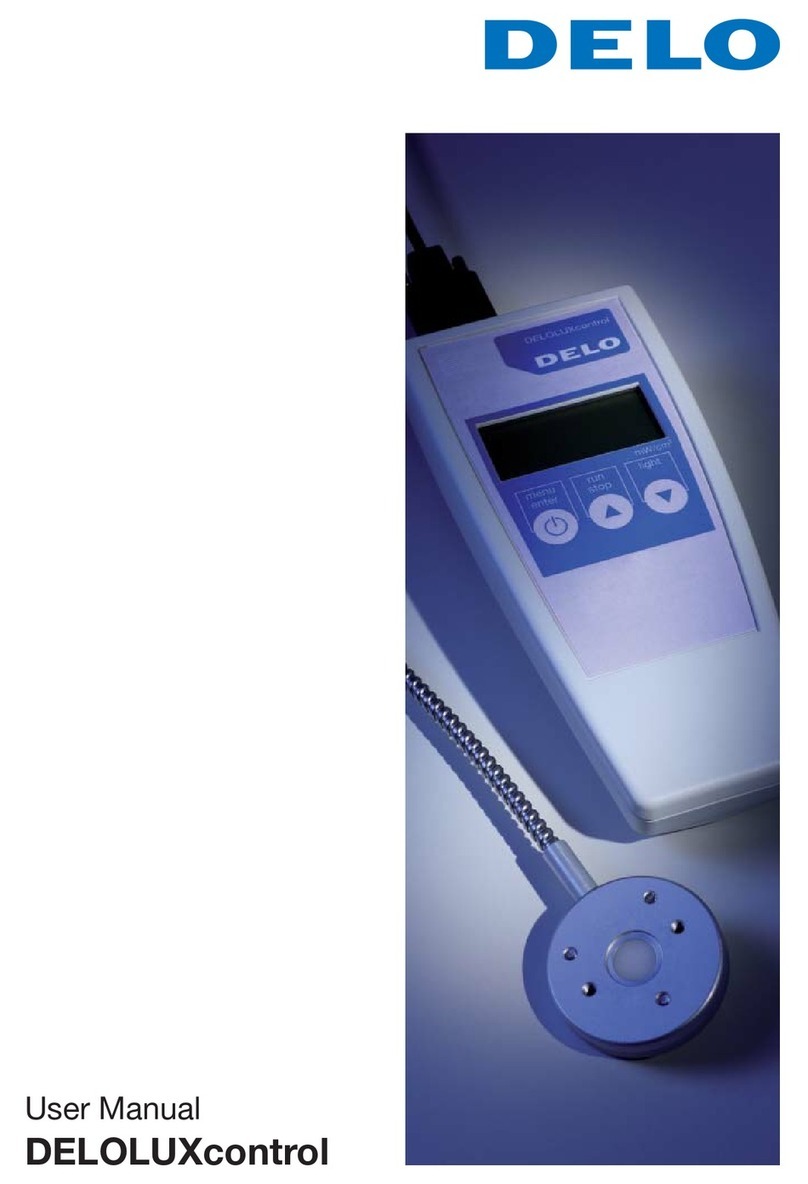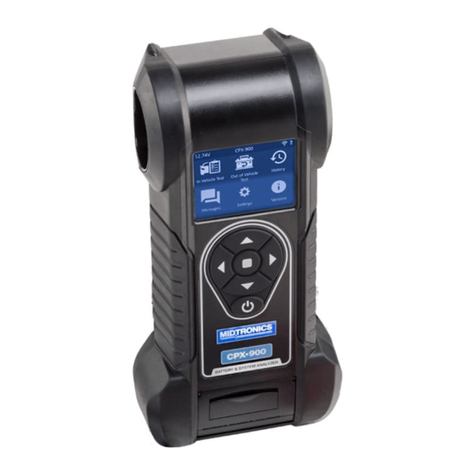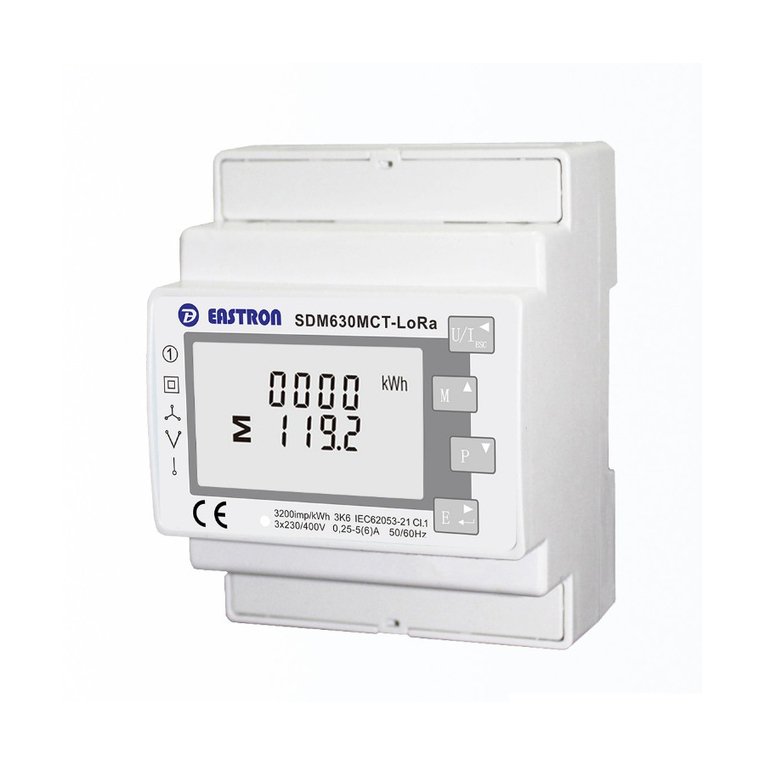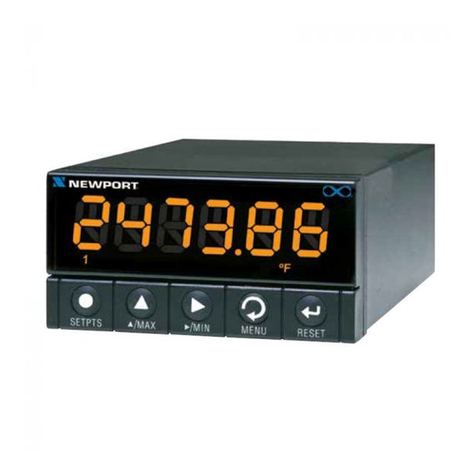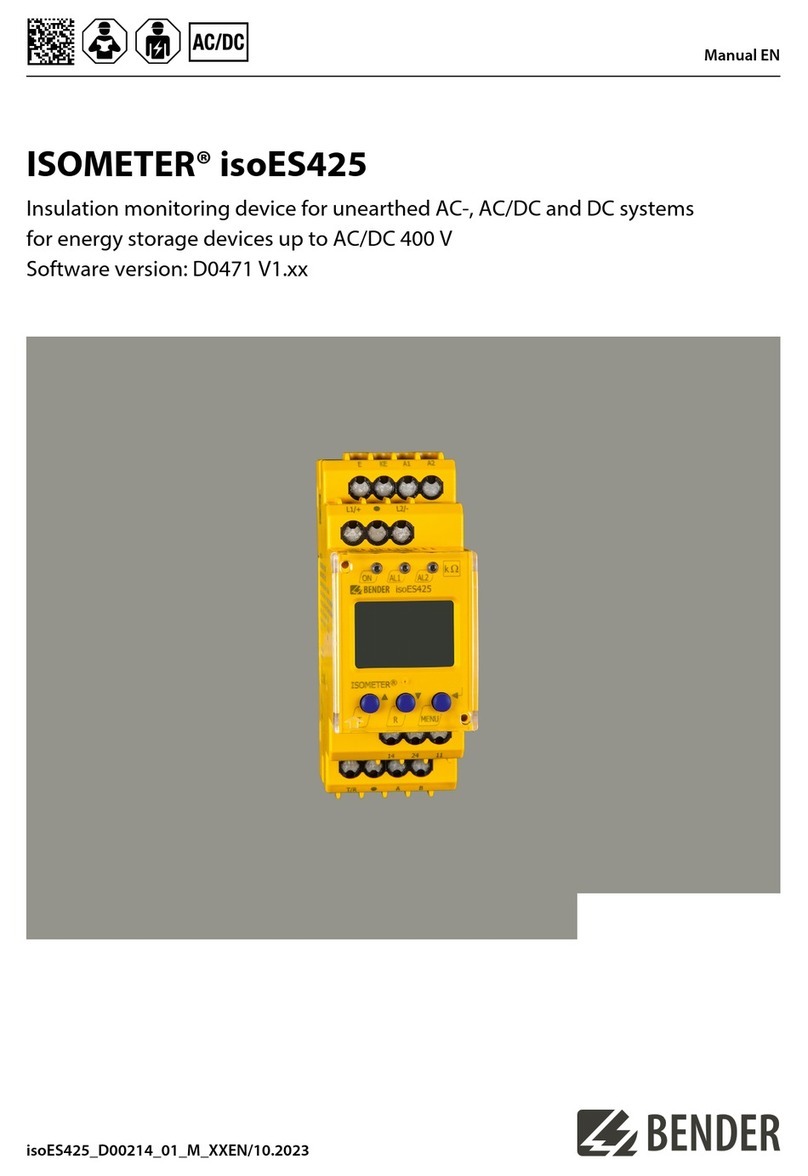PROVA 21 User manual

Power Harmonics and Leakage Tester
Model 21/23
Leakage and Harmonics Tester
Model 19
Users Manual
33
m
ERR
AUTO-POWER-OFF
Ture RMS
PROVA INSTRUMENTS INC.

EN61010-2-032
CAT II 600V
CAT III 300V
PollutionDegree2
Definition of Symbols:
Caution: Refer to Accompanying Documents
Caution: Risk of Electric Shock
Double Insulation
Over-voltage Category I (CAT I):
Equipment for connection to circuits in which measures are
taken to limit the transient over-voltages to an appropriate low
level.
Over-voltage Category II (CAT II):
Energy-consuming equipment to be supplied from the fixed
installation.
Over-voltage Category III (CAT III):
Equipment in fixed installations.
WARNING: If the clamp meter is used in a manner
Not specified by the manufacturer, the protection
Provided by the clamp meter may be impaired.

TABLE OF CONTENTS
I. FEATURES ................................................................................................................... 1
II. PANEL DESCRIPTION .............................................................................................. 2
III. OPERATING INSTRUCTIONS................................................................................. 5
III.1. Measurement of AC mA and A ........................................................................... 5
III.1.1. True RMS value of AC Current ..................................................................................6
III.1.2. HOLD, MAX, MIN and PEAK of AC Current. ........................................................7
III.1.3. Harmonics of AC Current in Magnitude (mA or A).................................................8
III.1.4. Harmonics of AC Current in Percentage (%)...........................................................8
III.1.5. Total Harmonic Distortion (% THD-F) ....................................................................9
III.1.6. Crest Factor (C.F.) ................................................................................................... 10
III.1.7 Frequency of AC Current ......................................................................................... 10
III.2 Measurement of AC Voltage.............................................................................. 11
III.2.1. True RMS value of AC Voltage................................................................................ 12
III.2.2. HOLD, MAX, MIN and PEAK value of AC Voltage............................................. 12
III.2.3. Harmonics of AC Voltage in Magnitude (V).......................................................... 13
III.2.4. Harmonics of AC Voltage in Percentage (%) ........................................................ 13
III.2.5. Total Harmonic Distortion (% THD-F) ................................................................. 14
III.2.6. Crest Factor (C.F.) ................................................................................................... 15
III.2.7 Frequency of AC voltage .......................................................................................... 15
III.3 Measurement of Single Phase AC Power Quality (21, 23)............................. 16
III.3.1 Single Phase AC Watt ............................................................................................... 17
III.3.2. Apparent Power (VA, KVA) and Reactive Power (VAR, KVAR).......................... 17
III.3.3. Power Factor (PF), and Phase Angle (Φ)............................................................. 18
III.3.4. Horse Power (H.P.).................................................................................................. 19
III.3.5. Energy (mWH, WH, or KWH) ................................................................................ 19
III.4 Measurement of the Balanced 3 Phase AC Power Quality (21, 23) .............. 20
III.5 Measurement of the Balanced 3 Phase Sequence (21, 23)........................... 21
IV. SET THE CT RATIO ................................................................................................ 22
V. DISABLE AUTO-POWER-OFF .............................................................................. 22
VI. SPECIFICATIONS (23°C±5°C) .............................................................................. 23
VII. BATTERY REPLACEMENT ................................................................................. 31
VIII. MAINTENANCE & CLEANING........................................................................... 32

1
I. FEATURES
a. Active (W, KW, HP), reactive (VAR, KVAR) and apparent (VA, KVA) power.
b. Power factor (PF), phase angle (Φ), and energy (mWH, WH, KWH).
c. Measurement of standby power consumption for IT products.
d. Non-interrupted AC current harmonic analysis.
e. 1 to 99th order of harmonics at 1.0% basic accuracy.
f. Total harmonic distortion (%THD-F) and crest factor (CF).
g. True RMS measurement of V and A at 0.5% basic accuracy.
h. Fast peak function (39μs for 50 Hz, 33μs for 60Hz).
i. Measurement of balanced 3Φpower.
j. Measurement of balanced 3Φsequence.
k. Programmable CT ratio from 1 to 250.
l. Max, Min and data hold functions.
m. Leakage current measurement at 10μA resolution.
n. Active power in H.P.
o. Auto power off function in 30 minutes.
p. Shielded Jaw immune to external interference (Model 19, 21)

2
II. PANEL DESCRIPTION
33
m
ERR
AUTO-POWER-OFF
Ture RMS
1. Transformer Jaw Assembly
This is used to pick up current signal. To measure AC current or Power/Watt, the jaw
must enclose conductor completely.
2. Transformer Trigger
Press the trigger to open the jaw.
3. Rotary Switch
This is used to turn the power on and select measurement of current, voltage or
power.
4. MAX/MIN/HOLD/PEAK and ▼Button
In the measurement of mA, A, or V, press this button to perform function of
MAXIMUM, MINIMUM, HOLD and PEAK. It is also used to decrement the order of
harmonics or CT ratio.
If this button is hold when turning on power, the tester can perform measurement of
phase sequence instead of phase angle in the balanced 3Φpower system.

3
5. ▲3ΦButton
This button is used to increment order of harmonics or CT ratio. When the rotary
switch is set at W-mA or W-A position, press this button to select measurement of
balanced 3Φpower instead of single-phase power.
This button is also used to select AUTO Hz. If users hold this button and turn the
power on, the unit will automatically detect the frequency of the signal within 40 to 65
Hz. If the frequency is outside 40 to 65 Hz, the unit will select 50 or 60 Hz based
upon the position of sliding switch 18.
6. FUNC Button
In the measurement of mA, A, or V, press this button to select function of harmonics,
THD-F, or CF. In the measurement of W-mA or W-A, press this button to select
function of VA, VAR, PF, phase angle, HP, or energy (KWH).
7. LCD
This is a 4+2+2 digit Liquid Crystal Display. Function symbols, units, sign, decimal
points, low battery symbols, max, min symbols, peak and harmonic symbols are
included.
8, 9, 10, 12
Those are symbols of selected functions such as, Harmonic, PEAK, MAX, MIN or
HOLD.
11. Primary Digits
These digits display the value of measurement, such as current, voltage, or power.
13. Symbols of Units
These are symbols of current, voltage, and power. There are two digits used to
display the fundamental frequency 50 or 60 Hz.
14. V Input Terminal
This terminal is used as input for voltage and power measurements.
15. COM Terminal
This terminal is used as common reference input.
16. Hand Strap
Put your hand through the hole of hand strap to avoid accidental drop of the clamp
meter.

4
18. Sliding Switch
Users should select the correct fundamental frequency (50/60 Hz) by moving the
sliding switch to a correct position.

5
III. OPERATING INSTRUCTIONS
III.1. Measurement of AC mA and A
NOTE:
1. Select the correct fundamental frequency (50 or 60 Hz) of current by moving the
sliding switch at the side of the tester. Or hold the ▲ button to select AUTO Hz.
2. Select the proper position of the rotary switch for the range of current. If the AC
current is less than 0.6A, then set the rotary switch at the position of mA. If the
AC current is greater than 0.6A, then set the rotary switch at the position of A.
3. If the peak value of the input AC current is greater than the maximum value of
the range, then symbol of OL will be displayed.
4. If users hold the ▲ button and turn the power on, the unit enters the AUTO Hz
mode. The unit will automatically detect the frequency between 45 to 65Hz.
Additional error occurs if the measured frequency is not 50 or 60 Hz.
NOTE: Whenever the rotary switch is set at a new position, the CT ratio and
fundamental frequency will be displayed first.
WARNING: If the unit clamps on to a load (current) about twice the range, the unit
not only display OL, but also display Low Battery.
NOTE: If the CT ratio is not 1, a symbol of “CT” will be shown in the LCD display
for the measurement of mA or A. The reading of current shown in LCD is equal to
the true RMS value measured by the tester multiplied by CT ratio (A LCD = ARMS ×
CT).

6
+
TureRMS
AUTO-POWER-OFF
ERR
m
3
3
WARNING: Make sure that all the test leads are disconnected from the meter's
terminals for current measurement.
III.1.1. True RMS value of AC Current

7
a. Set the rotary switch at mA or A depending on the range of AC current.
Then select the correct frequency by moving the sliding switch at the side
of the tester.
b. Press the trigger to open the jaw and fully enclose the conductor to be
measured.
c. Read the measured value from the LCD display.
III.1.2. HOLD, MAX, MIN and PEAK of AC Current.
a. Set the rotary switch at mA or A depending on the range of AC current.
Then select the correct frequency by moving the sliding switch at the side
of the tester.
b. Press the trigger to open the jaw and fully enclose the conductor to be
measured.
c. The measured value from the LCD display. If the ▼button is pressed,
the symbol of “HOLD”, “MAX”, “MIN” or “PEAK” will be shown in LCD
alternatively. And the value of the HOLD, MAX, MIN or PEAK function will
be displayed in LCD alternatively.
d. To return to the display of current measurement, hold the ▼button for
more than 2 seconds.
NOTE: The PEAK function displays the maximum value of a AC periodic
waveform. The sampling time for the PEAK function is 39 μs (50Hz) or 33μs
(60Hz). The HOLD, MAX, or MIN function displays the true RMS value.

8
III.1.3. Harmonics of AC Current in Magnitude (mA or A)
a. Set the rotary switch at the position of “mA” or “A” depending on the range
of AC current. Then select the correct fundamental frequency by moving
the sliding switch at the side of the tester.
b. Press the trigger to open the jaw and fully enclose the conductor to be
measured.
c. Press the FUNC button once. The symbols of “Harmonic” and “NO” will
be shown in LCD. The n-th order (1 to 99) will be shown in front of the
reading of the magnitude (mA or A) of the current.
d. Press the
▲or ▼button to increment or decrement the order of
harmonics in front of the reading. The number will roll over when the
maximum (99) or minimum (1) is reached.
III.1.4. Harmonics of AC Current in Percentage (%)
a. Set the rotary switch at the position of “mA” or “A” depending on the range
of AC current. Then select the correct fundamental frequency by moving
the sliding switch at the side of the tester.
b. Press the trigger to open the jaw and fully enclose the conductor to be

9
measured.
c. Press the FUNC button twice. The symbols of “Harmonic” and “NO” will
be shown in LCD. The n-th order (1 to 99) will be shown in front of the
reading of the percentage (%) of the current.
d. Press the
▲or ▼button to increment or decrement the order of
harmonics in front of the reading. The number will roll over when the
maximum (99) or minimum (1) is reached.
III.1.5. Total Harmonic Distortion (% THD-F)
a. Set the rotary switch at the position of “mA” or “A” depending on the range
of AC current. Then select the correct fundamental frequency by moving
the sliding switch at the side of the tester.
b. Press the trigger to open the jaw and fully enclose the conductor to be
measured.
c. Press the FUNC button three times. The symbols of “THD” and “%” will be
shown in LCD. The total harmonic distortion in percentage with respect to
the fundamental frequency (50 or 60 Hz) will be measured and displayed.
%THD-F = (√(V22+ V32+ … V492+ V502) / V1) * 100
Where,
V1: magnitude at the fundamental frequency
V2: magnitude at the second harmonics
…
V50: magnitude at the 50-th harmonics.
NOTE: In the measurement of THD, the response to the button or switch
operation becomes slow due to heavy math calculation.

10
III.1.6. Crest Factor (C.F.)
a. Set the rotary switch at the position of “mA” or “A” depending on the range
of AC current. Then select the right frequency by moving the sliding switch
at the side of the tester.
b. Press the trigger to open the jaw and fully enclose the conductor to be
measured.
c. Press the FUNC button four times. The symbol of C.F. will be shown in
LCD. The crest factor (C.F.) will be measured and displayed. The crest
factor (CF) is defined as following:
C.F. = (peak value) / (RMS value)
III.1.7 Frequency of AC Current
a. Set the rotary switch at the position of “mA” or “A” depending on the range
of AC current.
b. Press the trigger to open the jaw and fully enclose the conductor to be
measured.
c. Press the FUNC button five times. The symbol of Hz will be shown in
LCD.
d. The frequency of AC current will be measured and shown in LCD. If the
frequency is less than 40 Hz, 0 Hz will be shown in LCD. If the frequency
is greater than 65 Hz, OL Hz will be shown in LCD.
NOTE: In the mA range, the AC current must be greater than 10mA for frequency
measurement. In the A range, the AC current must be greater than 1A for
frequency measurement.

11
III.2 Measurement of AC Voltage
NOTE:
1. Select the correct fundamental frequency of voltage by moving the sliding switch
at the side of the tester.
2. If the peak value of the input AC voltage is greater than the maximum value of the
range, then symbol of OL will be displayed.
3. If users hold the ▲ button and turn the power on, the unit enters the AUTO Hz
mode. The unit will automatically detect the frequency between 45 to 65Hz.
Additional error occurs if the measured frequency is not 50 or 60 Hz.
NOTE: Whenever the rotary switch is set at a new position, the CT ratio and
fundamental frequency will be displayed first.
NOTE: If the CT ratio is not 1, a symbol of “CT” will be shown in the LCD display.
WARNING: Maximum input for ACV is 600. Do not attempt to take any
voltage measurement that exceeds the limits. Exceeding the limits could cause
electrical shock and damage to the clamp meter.
3
Ture RMS
AUTO-POWER-OFF

12
III.2.1. True RMS value of AC Voltage
a. Set the rotary switch at position V. Then select the correct fundamental
frequency by moving the sliding switch at the side of the tester.
b. Insert the test leads into the input jack. Connect the test prods of the test
leads in PARALLEL to the circuit to be measured.
c. Read the measured RMS value from the LCD display.
III.2.2. HOLD, MAX, MIN and PEAK value of AC Voltage
a. Set the rotary switch at position V. Then select the correct fundamental
frequency by moving the sliding switch at the side of the tester.
b. Insert the test leads into the input jack. Connect the test prods of the test
leads in PARALLEL to the circuit to be measured.
c. The measured value is displayed in the LCD display. If the ▼button is
pressed, the symbol of “HOLD”, “MAX”, “MIN” or “PEAK” will be shown in
LCD alternatively. And the value of the HOLD, MAX, MIN or PEAK
function will be displayed in LCD alternatively.
d. To return to the display of current measurement, hold the ▼button for
more than 2 seconds.
NOTE: NOTE: The PEAK function displays the maximum value of a AC periodic
waveform. The sampling time for the PEAK function is 39 μs (50Hz) or 33μs (60Hz).
The HOLD, MAX, or MIN function displays the true RMS value.

13
III.2.3. Harmonics of AC Voltage in Magnitude (V)
a. Set the rotary switch at position V. Then select the correct fundamental
frequency by moving the sliding switch at the side of the tester.
b. Insert the test leads into the input jack. Connect the test prods of the test
leads in PARALLEL to the circuit to be measured.
c. Press the FUNC button once. The symbols of “Harmonic” and “NO” will
be shown in LCD. The n-th order (1 to 99) will be shown in front of the
reading of the reading of the magnitude (V) of the voltage.
d. Press the
▲or ▼button to increment or decrement the order of
harmonics in front of the reading. The number will roll over when the
maximum (99) or minimum (1) is reached.
III.2.4. Harmonics of AC Voltage in Percentage (%)
a. Set the rotary switch at position V. Then select the correct fundamental
frequency by moving the sliding switch at the side of the tester.
b. Insert the test leads into the input jack. Connect the test prods of the test
leads in PARALLEL to the circuit to be measured.
c. Press the FUNC button twice. The symbols of “Harmonic” and “NO” will
be shown in LCD. The n-th order (1 to 99) will be shown in front of the
reading of the percentage (%) of the voltage.
d. Press the
▲or ▼button to increment or decrement the order of
harmonics in front of the reading. The number will roll over when the
maximum (99) or minimum (1) is reached.

14
III.2.5. Total Harmonic Distortion (% THD-F)
a. Set the rotary switch at position V. Then select the correct fundamental
frequency by moving the sliding switch at the side of the tester.
b. Insert the test leads into the input jack. Connect the test prods of the test
leads in PARALLEL to the circuit to be measured.
c. Press the FUNC button three times. The symbols of “THD” and “%” will be
shown in LCD. The total harmonic distortion in percentage with respect to
the fundamental frequency (50 or 60 Hz) will be measured and displayed.
%THD-F = (√(V22+ V32+ … +V492+ V502) / V1) * 100
Where,
V1: magnitude at the fundamental frequency
V2: magnitude at the second harmonics
…
V50: magnitude at the 50-th harmonics.
NOTE: In the measurement of THD, the response to the button or switch
operation becomes slow due to heavy math calculation.
NOTE: For model 23, users can not disable the auto-power-off function
by holding the FUNC button for 2 seconds in the measurement of THD.

15
III.2.6. Crest Factor (C.F.)
a. Set the rotary switch at position V. Then select the correct fundamental
frequency by moving the sliding switch at the side of the tester.
b. Insert the test leads into the input jack. Connect the test prods of the test
leads in PARALLEL with the circuit to be measured.
c. Press the FUNC button four times. The symbol of C.F. will be shown in
LCD. The crest factor (C.F.) will be measured and displayed. The crest
factor (CF) is defined as following:
C.F. (Crest Factor) = (Peak Value) / (RMS Value)
III.2.7 Frequency of AC voltage
a. Set the rotary switch at position V.
b. Insert the test leads into the input jack. Connect the test prods of the test
leads in PARALLEL with the circuit to be measured.
c. Press the FUNC button five times. The symbol of Hz will be shown in
LCD.
d. The frequency of AC voltage will be measured and shown in LCD. If the
frequency is less than 40 Hz, 0 Hz will be shown in LCD. If the frequency
is greater than 65 Hz, OL Hz will be shown in LCD
NOTE: The AC voltage must be greater than 50V for frequency measurement.

16
III.3 Measurement of Single Phase AC Power Quality (21, 23)
NOTE:
1. Select the correct fundamental frequency of current and voltage by moving the
sliding switch at the side of the tester.
2. Select the proper position of the rotary switch for the range of current. If the AC
current is less than 0.6A, then set the rotary switch at the position of W-mA. I
f
the AC current is greater than 0.6A, then set the rotary switch at the position o
f
W-A.
3. If the peak value of the input AC current is greater than the maximum value o
f
the range, then symbol of OL will be displayed.
4. If users hold the ▲ button and turn the power on, the unit enters the AUTO Hz
mode. The unit will automatically detect the frequency between 45 to 65Hz.
Additional error occurs if the measured frequency is not 50 or 60 Hz.
NOTE: Whenever the rotary switch is set at a new position, the CT ratio and
fundamental frequency will be displayed first.
NOTE: If the CT ratio is not 1, a symbol of “CT” will be shown in the LCD display for
the measurement of W-mA or W-A.
AUTO-POWER-OFF
TureRMS
-- +
+
--
+
3

17
III.3.1 Single Phase AC Watt
a.Connect the test leads to the voltage source in parallel with the load.
b.Clamp on one of the wire to the load. The current should flow from the front of
the tester to the side of the battery cover.
c. Select proper Watt range (W-mA or W-A).
d.Read the value shown on LCD in mW, W, or KW. The unit of watt is
automatically scaled.
III.3.2. Apparent Power (VA, KVA) and Reactive Power (VAR, KVAR)
a.Connect the test leads to the voltage source in parallel with the load.
b.Clamp on one of the wire to the load. The current should flow from the front of
the tester to the side of the battery cover.
c. Select proper Watt range (W-mA or W-A).
d.The value of mW, W, or KW will be displayed in LCD. The unit of watt is
automatically scaled.
e.Press the FUNC button once to display VA or KVA. The unit is automatically
scaled.
f. Press the FUNC button twice to display VAR or KVAR. The unit is
automatically scaled.
This manual suits for next models
2
Table of contents
Other PROVA Measuring Instrument manuals
Popular Measuring Instrument manuals by other brands

Bacharach
Bacharach Fyrite INTECH Configuration and operation manual
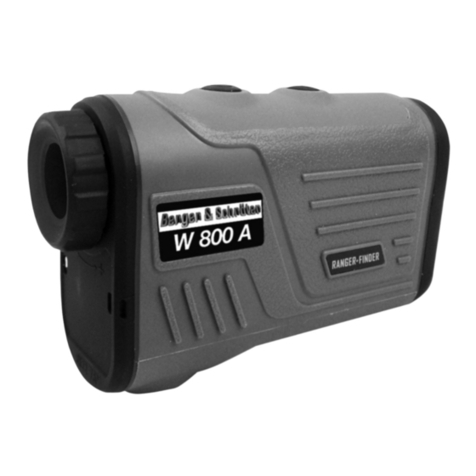
Berger & Schroter
Berger & Schroter W 800 A operating instructions

PCB Piezotronics
PCB Piezotronics IMI Sensors Y626B03 Installation and operating manual
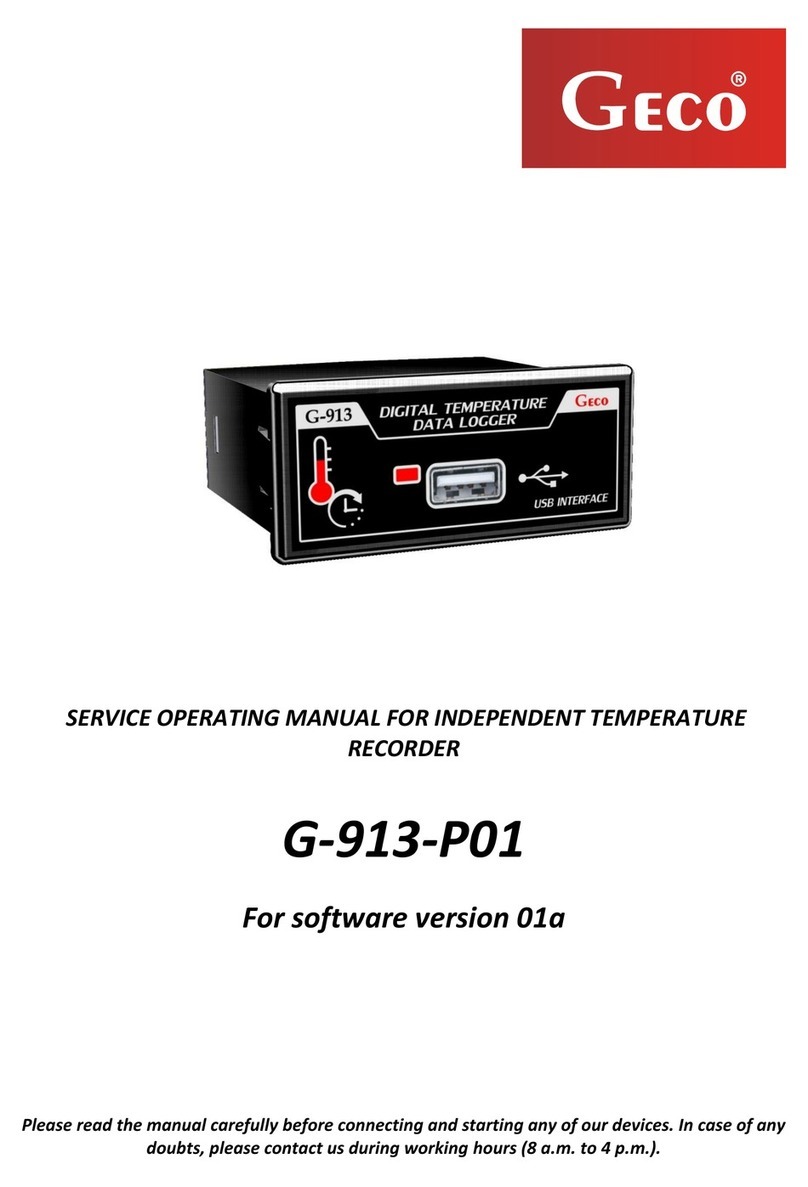
Geco
Geco G-913-P01 Service & operating manual
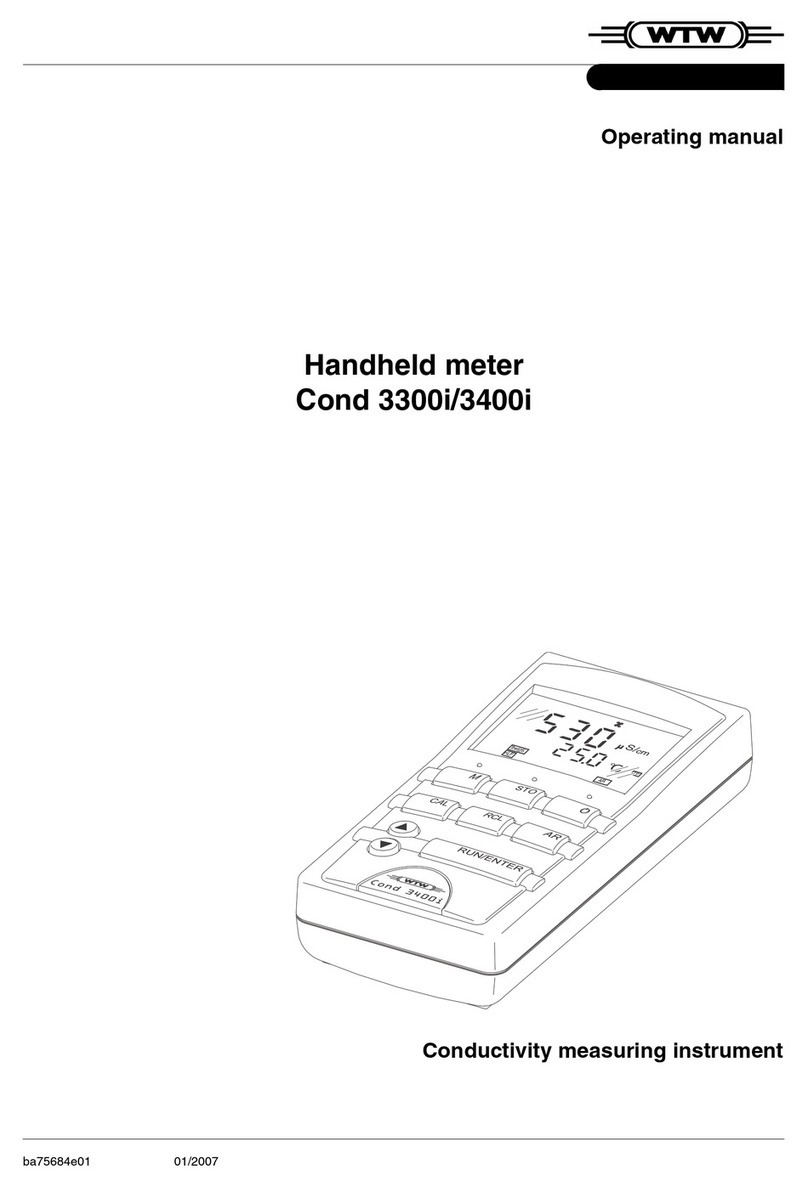
wtw
wtw Cond 3300i operating manual
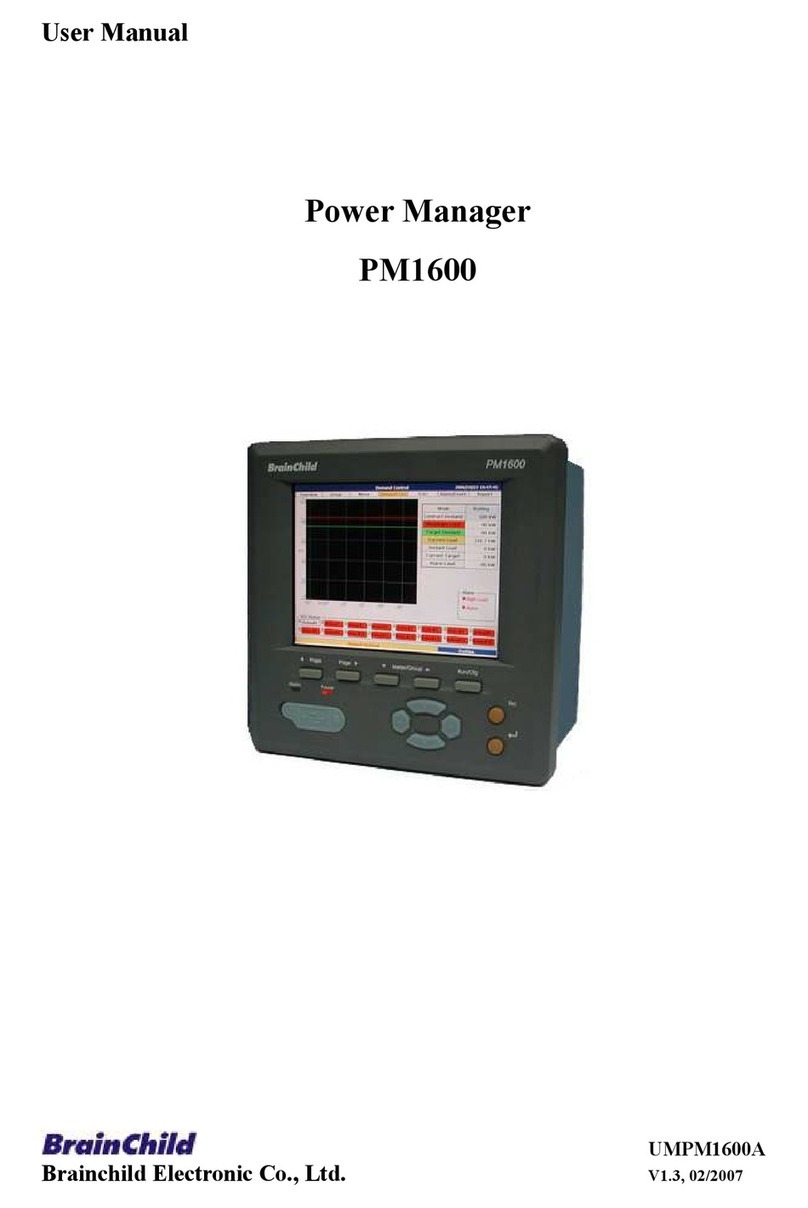
Brainchild
Brainchild PM1600 user manual
